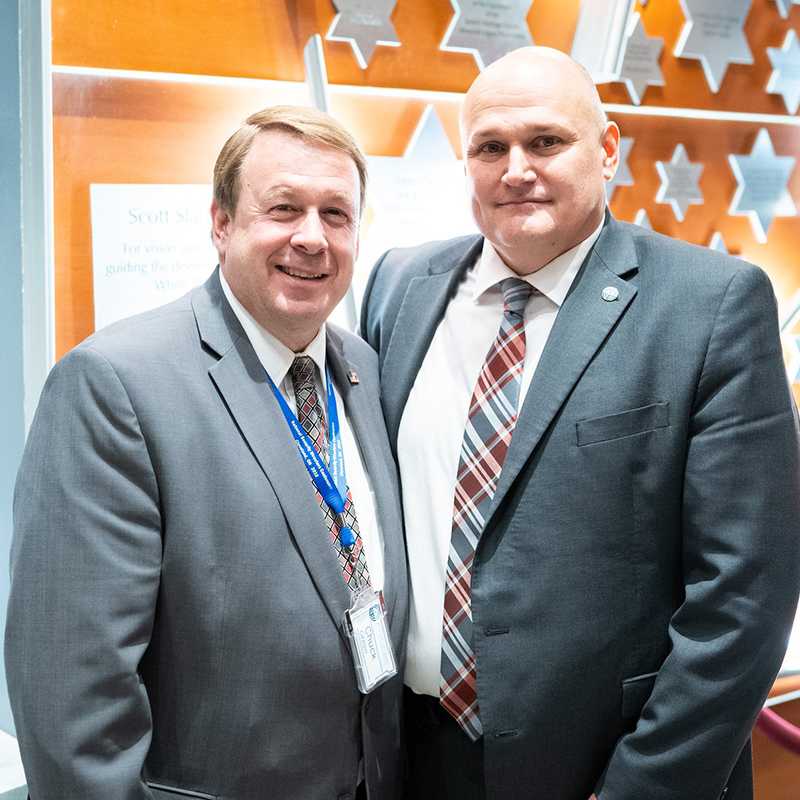If you ask Director of Community Security Chuck Green what’s on his to-do list, he’ll likely rattle off 10 projects that have him going in 10 different directions, working with multiple organizations and synagogues at one time.
Perhaps the most visible symbol of community security is seeing Green, head security guard Ty Fernandez and the rest of the security team manning the desks and greeting visitors at the Jewish Community Campus. And while managing and coordinating that team and security at the Campus is a big part of Green’s job, community security is so much more than that.
“A lot of people don’t really understand exactly what I am in terms of what I’m here to do,” Green said.
The projects he works on run the gamut from helping congregations find off-duty officers for special events, to walking through Union Station to discuss potential security concerns ahead of the upcoming “Auschwitz: Not Long Ago. Not Far Away.” exhibit, to working with The J during its recent construction to make sure existing and newly added security measures work properly.
As director of community security, Green is essentially on retainer for the organizations, agencies and synagogues in the community. He is there for all their security questions and needs.
Green last month celebrated his four-year anniversary in the post, and his presence is particularly poignant this time of year, when the community remembers the three murders committed by a white supremist at the Campus and Village Shalom on April 13, 2014. The security director position came about as a direct result of that incident.
The Jewish Federation of Greater Kansas City later hired Green, a former Secret Service agent, to help develop and implement a comprehensive, long-term community security plan. He says a lot of people don’t understand why he’s not actually doing their security, as in patrolling the parking lot or keeping an eye on things.
“I tell them, ‘I’m not here to do your security, I’m here for your security,’” he said. “I’m here to make the security the best it can be and make it easier to understand.”
He’s also here to help find solutions. When Congregation Beth Shalom was having trouble finding a security officer for its preschool, a shift that runs from 8:30 a.m. to 12:30 p.m, staff contacted Green. Since no security company could provide them with an officer for only 20 hours a week, the Campus decided to share one of its guards with Beth Shalom. He starts his shift at the preschool and then finishes at the Campus from 1:00 to 2:30 p.m.
“It actually works out pretty good because we needed someone in the middle of the day to bridge a security shift that starts at 5:00 a.m. at The J and goes to 1:00 p.m.,” Green said. “That’s an eight-hour shift and the next shift doesn’t start until 2:30. We needed someone in those middle hours, and he helps out with HBHA pick-up.”
Assuaging fears is another part of Green’s job. When a parent at HBHA had concerns after the Capitol riots, Green responded with a list of all the things that have been done in the past few years to make the school safer. He’s currently working with the school on security upgrades to its front entrance, including installing bullet resistant glass.
“We have had a great working relationship with Chuck and his team. The added layers of security — including planning, tools and training for a variety of scenarios — gives our parents and staff a greater peace of mind, day in and day out,” said Adam Tilove, HBHA head of school.
Another aspect of community security is making sure agencies and organizations spend wisely on security upgrades. “You can put a lot of money into things for no reason,” Green said.
Like putting security lights in places where they’re not necessarily needed. Or investing in bullet-proof glass for a door or window that’s in a sunny spot; bullet-proof glass is very susceptible to UV light and will lose its effectiveness if it’s placed somewhere the sun will hit it every day.
When The Temple, Congregation B’nai Jehudah was undergoing its recent renovation, Green worked with its security committee and board to provide guidance and security recommendations.
"Chuck Green has been a constant source of knowledge and strength since I started my tenure at Congregation B’nai Jehudah,” said Jennifer Green Baer, executive director, “working with our team from the beginning of our building renovation — suggesting security measures and processes — and continuing to inform, promote and support all of our congregational needs.”
Funding our security future
While security is a necessary part of our community, it’s also an expensive one. The cost for security runs about $500,000 a year for the security guards and other operational costs, and that doesn’t include purchases like metal detectors for special events. While grants help fund community security and security for individual agencies and synagogues, a lot of money also comes from private donors.
“It’s because of the donors around the Jewish community who are generous and give towards these things that we have the kind of security we do,” Green said.
In 2016, a small group of foundations and benefactors made multi-year commitments to help the Federation establish a fund to cover five-years-worth of security operations. As that initial funding approaches its end, Federation is continuing to raise funds from other sources, including many partner funders and agencies.
“We’ve made great strides in this area but will need the help of key benefactors who have contributed previously — as well as new donors — to ensure that we can maintain and build on our strong security foundation as we move forward into the next 10 years,” said Helene Lotman, Federation president and CEO.
Green said it’s becoming more and more apparent — to our Jewish community and others — that security is a communal responsibility.
“I think it’s a realization throughout the Jewish community as a whole, throughout the United States and the rest of the world, that security is everybody’s responsibility and the brunt of the costs of these things needs to be spread out,” he said.



